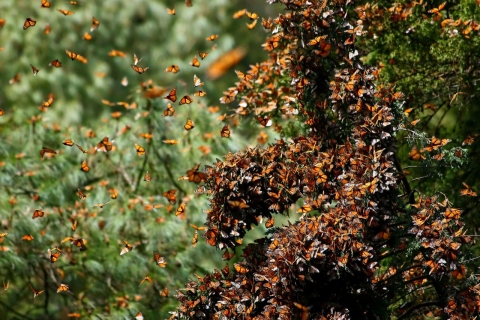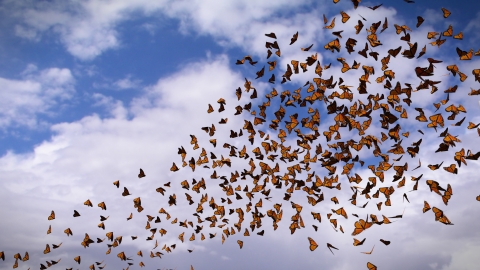In autumn, when leaves on trees across Canada and the United States begin to change color and fall to the ground, trees in rugged mountain forests in central Mexico change color too. But their orange coats don’t fade and fall. They cling on in clusters, sometimes bending the trees beneath their weight.
In these evergreen forests, the fall color isn’t foliage. It’s millions of monarch butterflies.
Winter getaway
Almost all migratory monarchs that breed in eastern North America spend their winters in the oyamel fir forests in Mexico’s Monarch Butterfly Biosphere Reserve.
Their journey is one of the longest known insect migrations in the world, and one of the most astonishing. Butterflies that weigh less than a paper clip fly up to 3,000 miles over the course of two months as they travel from breeding areas in Canada and the northern United States to central Mexico.
Remarkably, they do so without ever having made this journey before. The butterflies that migrate south are the great — or great-great — grandchildren of monarchs that migrated north in the spring. How they navigate thousands of miles across unfamiliar terrain to a specific mountain range in Mexico remains a mystery, though it’s likely they orient using a combination of the sun’s angle and the Earth’s magnetic field.
While there is a western monarch population that overwinters in California, and some monarchs that don’t migrate at all, the eastern population is the largest in terms of range and number of individuals.
These monarchs are the lynchpin for their species, and the oyamel fir forests are the key to their survival.
An irreplaceable niche
Found only in moist, tropical areas at elevations between 8,000 and 12,000 feet, the oyamel fir forests provide an irreplaceable habitat niche for monarchs — the level of humidity and the temperature range are just right to prevent the butterflies from drying out or freezing while they roost.
For hundreds, possibly thousands, of years, monarchs have migrated to central Mexico, to an area known as the Transvolcanic Belt in the fall. And for just as long, people there have anticipated their return.
The monarch’s winter home is also the year-round home of Indigenous and local communities. Many people in this area consider the butterfly sacred. The monarch migration coincides with the fall festival of Día de los Muertos, or Day of the Dead, and to many local people, the butterflies signify the souls of their lost loved ones coming home.
Without this niche in the Transvolcanic Belt, these monarchs would have nowhere to go.
The future of the forest
In 1986, the Mexican government established the 56,000-hectare Monarch Butterfly Biosphere Reserve — an area about the size of Chicago — to protect the oyamel fir forests and the monarchs that overwinter there.
But addressing ongoing threats that encroach on wintering habitat — including clearing for agriculture, illegal logging, and severe storms — takes collaboration and coordination with partners working to address loss and degradation of habitat in other parts of the species’ enormous range. No single agency, or government, can protect the monarch alone.
Fortunately, it’s a shared priority for partners across the continent.
Sustaining habitat and livelihoods
In 1995, the United States launched a long-standing partnership with the Mexican non-governmental organization Alternare to protect overwintering habitat in the Monarch Biosphere Reserve.
Because nearly 30,000 people live in this region, efforts have focused on building capacity for sustainable forest management and agricultural production within local and Indigenous communities to support both their livelihoods and the future of the forest.
With support from the Service, Alternare established a training center and program focused on sustainable natural resource management with communities.
To date, more than 100 community-based extension workers have graduated from this center, and they have trained an additional 2,000 local farmers on topics including sustainable agriculture and soil, water, and forest conservation.
As a result, community members are on the frontlines restoring monarch habitat in priority areas by planting hundreds of thousands of oyamel firs, which are raised in nurseries supported by the very same communities.
Another partner in monarch conservation is World Wide Fund for Nature-México, which works with the Mexican government, communities, and other partners to enhance the Monarch Butterfly Biosphere Reserve by promoting sustainable forest management.
Local communities have also taken proactive measures to address potential threats. Most communities in the region have voluntarily formed citizens’ brigades to prevent fires, monitor for illegal logging activities, and reforest degraded areas.
Scaling efforts across the continent
In 1996, the United States, Mexico, and Canada signed a Memorandum of Understanding establishing the Trilateral Committee for Wildlife and Ecosystem Conservation and Management.
The Trilateral Committee facilitates cooperation and coordination among the wildlife agencies of the three nations to conserve and manage biodiversity, ecosystems, and species of mutual interest — including the monarch butterfly.
The tri-national North American Intergovernmental Committee on Cooperation for Protected Areas Conservation, or NAPA Committee, also provides a forum for collaborative monarch conservation.
The Service leads a working group under NAPA of its fellow U.S. member agencies – the Bureau of Land Management, National Park Service, U.S. Forest Service, and the U.S. Geological Survey – to develop a strategic action plan to advance monarch conservation on our lands.
In 2015, scientists from Canada, Mexico, and the United States formed the Tri-national Monarch Conservation Science Partnership to collaborate on research, monitoring, and data-sharing priorities.
Going the distance
As seasonal symbols — of spring and summer in Canada and the United States, and of fall in Mexico — monarchs give those who see them a sense of time and place.
For one person, monarchs might be a sign that their garden is in full bloom. For another, monarchs might signify that winter is on its way.
But their epic, centuries-old migration also connects us to others across the continent who share the same sense of wonder for these remarkable insects.
Partners have already been working together for decades to conserve a butterfly that connects us to our homes and to our North American neighbors.
We still have a ways to go to ensure the future of this species. But if monarchs can go the distance, so can we.
Learn more about our work to conserve the monarch and how you can get involved.








